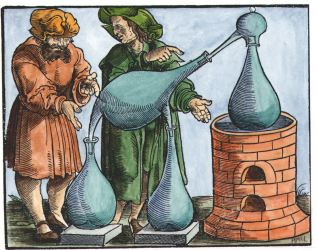| Author | Post |
|---|
Carl Lavoie
Member
| Joined: | Wed Feb 25th, 2009 |
| Location: | Canada |
| Posts: | 215 |
| Status: |
Offline
|
|
Posted: Sun Jan 29th, 2012 05:31 am |
|
.
A suggestion of a ‘structural’ classification of the alchemical symbols from the ‘Chymie’ entry of Diderot’s Encyclopédie (1751-1772) ; “regrouper leurs signes selon leur degré d’iconité”.
I'm a little dubious, though, of the value of such an arrangement.
René Ponot, pp. 65-79
http://www.persee.fr/web/revues/home/prescript/article/colan_0336-1500_1971_num_12_1_3903
.
|
Paul Ferguson
Member

| Joined: | Fri Feb 15th, 2008 |
| Location: | |
| Posts: | 1538 |
| Status: |
Offline
|
|
Posted: Sun Jan 29th, 2012 03:26 pm |
|
Carl Lavoie wrote:
.
A suggestion of a ‘structural’ classification of the alchemical symbols from the ‘Chymie’ entry of Diderot’s Encyclopédie (1751-1772) ; “regrouper leurs signes selon leur degré d’iconité”.
I'm a little dubious, though, of the value of such an arrangement.
René Ponot, pp. 65-79
http://www.persee.fr/web/revues/home/prescript/article/colan_0336-1500_1971_num_12_1_3903
.
There's something about this sort of activity on page 231 et seq. of Crosland's book, available here:
http://philoscience.unibe.ch/documents/kursarchiv/SS02/crosland2.pdf
The only practical use of such an exercise I can think of is to make it easier to construct a comprehensive classified list for tracking down particular symbols. Ponot was basically an historian of typography and had a theoretical interest in such matters.
|
adammclean
Member

| Joined: | Fri Sep 14th, 2007 |
| Location: | United Kingdom |
| Posts: | 606 |
| Status: |
Offline
|
|
Posted: Sun Jan 29th, 2012 08:14 pm |
|
Paul Ferguson wrote:
The only practical use of such an exercise I can think of is to make it easier to construct a comprehensive classified list for tracking down particular symbols. Ponot was basically an historian of typography and had a theoretical interest in such matters.
Fred Gettings for his Dictionary of occult, hermetic and alchemical sigils, London 1981, adopts a strategy of classifying each symbol under the number of strokes needed to create it. Thus, for example, he had an index of symbols created using four linear strokes, or a circle with two strokes, and so on.Last edited on Sun Jan 29th, 2012 08:19 pm by adammclean
|
Paul Ferguson
Member

| Joined: | Fri Feb 15th, 2008 |
| Location: | |
| Posts: | 1538 |
| Status: |
Offline
|
|
Posted: Sun Jan 29th, 2012 08:27 pm |
|
adammclean wrote:
Paul Ferguson wrote:
The only practical use of such an exercise I can think of is to make it easier to construct a comprehensive classified list for tracking down particular symbols. Ponot was basically an historian of typography and had a theoretical interest in such matters.
Fred Gettings for his Dictionary of occult, hermetic and alchemical sigils, London 1981, adopts a strategy of classifying each symbol under the number of strokes needed to create it. Thus, for example, he had an index of symbols created using four linear strokes, or a circle with two strokes, and so on.
I suppose a slightly more sophisticated version of that would be the radical-and-stroke system used for Chinese:
"Another form of collation is radical-and-stroke sorting, used for non-alphabetic writing systems such as Chinese hanzi and Japanese kanji, whose thousands of symbols defy ordering by convention. In this system, common components of characters are identified; these are called radicals in Chinese and logographic systems derived from Chinese."
http://en.wikipedia.org/wiki/Collation
It is, I suppose, possible to identify a certain number of 'radical' elements which go on to form the skeleton of more complex alchemical symbols.
Another point is that symbols that exhibit a similarity of form could imply a (conjectured) similarity of meaning, which might provide interesting insights into how our forefathers thought about certain alchemical topics, but I can't think of any precise examples at the moment.
|
adammclean
Member

| Joined: | Fri Sep 14th, 2007 |
| Location: | United Kingdom |
| Posts: | 606 |
| Status: |
Offline
|
|
Posted: Sun Jan 29th, 2012 08:59 pm |
|
I am not sure these classification systems correspond to anything actually encoded into the graphic signs. I suspect in most cases these graphic signs were created by individuals and then became accepted into a tradition of use, rather than there ever being a systematic structure behind them.
There are a few symbols which are obviously composite, such as those for Mercury sublimate and Mercury precipitate, in which the usual Metcury symbol has another symbol attached to it, namely the graphic for sublimation and precipitation, but there are only a few of these systematic forms.
|

Current time is 09:43 am | |
|
|
|

